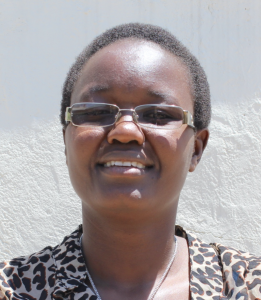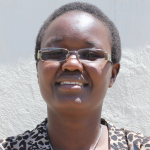"Fetching water from the spring is not enjoyable at all because, being young, we are forced to step inside the water as we fetch at the same time. This means we are taking home dirty water, but because we need water, we have no other options," said Anyango, a primary school-aged girl in Shianda who, along with some 300 other people in the area, depends on Mucharia Spring for water.
The spring's landowner, Mr. Wycliffe Mucharia, knows his spring is not providing his community with clean and safe water, but he has not had the resources to improve it on his own.
"The spring being open has forced us to endure consuming dirty water although we know that the water is not safe - but we have no choice."
The water at the spring is most contaminated during the rainy season when runoff directs soil, animal waste, and farm chemicals into the water. In all seasons, animals can walk straight through the pool of water community members collect from, drinking from the source and leaving their waste behind. Algae, water plants, and insects are constant companions in the spring.
Many of the community members and especially children have been treated for typhoid and diarrhea after consuming dirty water from Mucharia Spring. Women pray that the spring will be protected soon so that their children will no longer visit the hospital as they used to, they told us. Medicine and hospital visits drain families of their financial resources that were intended for other uses. When sick, adults miss out on productive work time, and kids have to stay home from school. Everyone is being held back by this spring who uses it.
Access is the other major challenge at Mucharia Spring. To fetch water, people must either stand directly in the water they are fetching or try to balance on a few slippery stones. Then, they have to scoop the water from the surface using small jugs or bowls to then pour into their larger jerrycans.
The scoop-pour method is time-consuming and tiring, and crowds are constant as people wait their turn to fetch water. While most women would prefer to fetch water in the morning so they can attend to the rest of their daily activities, this is not the routine at Mucharia Spring. Instead, women here are forced to fetch water in the morning, noon, and evening due to the long lines.
As people wait, many conflicts arise because each person wants to fetch water quickly so they can get on with their day. There is also some competition as the more people fetch water, the more mud gets churned up in the water and the longer people have to wait for it to settle before fetching can begin again.
Cleaning the spring after the rains is another issue as the entire area can become filled in with eroded soil and other debris. Clearing the spring takes a lot of time and energy and is left for the women to attend to. But they are already losing so much of their day to fetching water that no one wants to sacrifice more of their day to the extra work at the spring.
What We Can Do:
Spring Protection
Protecting the spring will help provide access to cleaner and safer water and reduce the time people have to spend to fetch it. Construction will keep surface runoff and other contaminants out of the water. With the community’s high involvement in the process, there should be a good sense of responsibility and ownership for the new clean water source.
Fetching water is a task predominantly carried out by women and young girls. Protecting the spring and offering training and support will, therefore, help empower the female members of the community by freeing up more of their time and energy to engage and invest in income-generating activities and their education.
Training on Health, Hygiene, COVID-19, and More
To hold trainings during the pandemic, we work closely with both community leaders and the local government to approve small groups to attend training. We ask community leaders to invite a select yet representative group of people to attend training who will then act as ambassadors to the rest of the community to share what they learn. We also communicate our expectations of physical distancing and wearing masks for all who choose to attend.
The training will focus on improved hygiene, health, and sanitation habits in this community. We will also have a dedicated session on COVID-19 symptoms, transmission routes, and prevention best practices.
With the community’s input, we will identify key leverage points where they can alter their practices at the personal, household, and community levels to affect change. This training will help to ensure participants have the knowledge they need about healthy practices and their importance to make the most of their water point as soon as water is flowing.
Our team of facilitators will use a variety of methods to train community members. Some of these methods include participatory hygiene and sanitation transformation, asset-based community development, group discussions, handouts, and demonstrations at the spring.
One of the most important issues we plan to cover is the handling, storage, and treatment of water. Having a clean water source will be extremely helpful, but it is useless if water gets contaminated by the time it is consumed. We and the community strongly believe that all of these components will work together to improve living standards here, which will help to unlock the potential for these community members to live better, healthier lives.
We will then conduct a small series of follow-up trainings before transitioning to our regularly scheduled support visits throughout the year.
Training will result in the formation of a water user committee, elected by their peers, that will oversee the operations and maintenance of the spring. The committee will enforce proper behavior around the spring and delegate tasks that will help preserve the site, such as building a fence and digging proper drainage channels. The fence will keep out destructive animals and unwanted waste, and the drainage will keep the area’s mosquito population at a minimum.

 Protected Spring
Protected Spring
 Rehabilitation Project
Rehabilitation Project



































